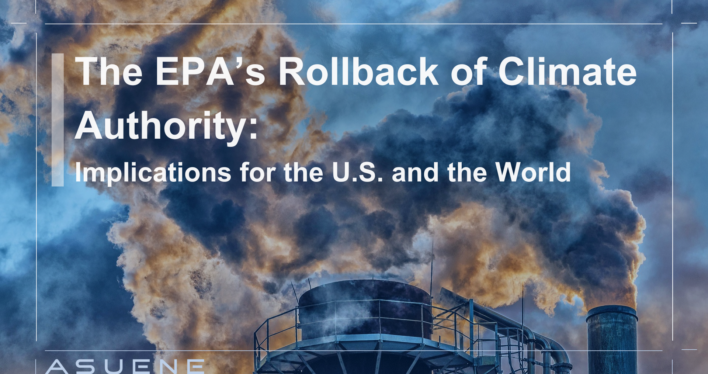- Article Summary
-
Introduction: A Pivotal Turn in U.S. Climate Policy
On July 29, 2025, the U.S. Environmental Protection Agency (EPA), led by Administrator Lee Zeldin under the Trump administration, proposed a major policy shift: the revocation of the 2009 Endangerment Finding. This foundational scientific and legal determination has, for over a decade, enabled the federal regulation of greenhouse gases (GHGs) under the Clean Air Act. The proposed rollback represents a significant turning point in U.S. climate policy and has sparked immediate concern across scientific, legal, and international communities.
If this finding is revoked, the federal government’s capacity to manage GHG emissions could be severely curtailed, including the ability to set limits for power plants, automobiles, and other sectors. The policy proposal has elicited swift and critical responses. Environmental organizations warn of cascading setbacks to climate action, while some political and industry voices praise the rollback as a move to restore regulatory balance.
What Is the Endangerment Finding and Why It Matters
The Endangerment Finding was born out of the 2007 Supreme Court ruling in Massachusetts v. EPA, which found that the agency could not ignore greenhouse gases under the Clean Air Act. This decision obligated the EPA to evaluate the risks of such emissions, and in 2009, the agency formally concluded that six major greenhouse gases threaten public health and welfare. This legal finding provided the regulatory foundation for addressing climate-related emissions from sources such as vehicles, industrial facilities, and power plants.
These findings supported the EPA’s legal authority to intervene in GHG emissions. The Finding is central not only to EPA rulemaking but also to broader U.S. climate strategy. Without it, many existing and future rules could be challenged or rescinded.
If revoked, the EPA would lose the foundational justification for regulating emissions like carbon dioxide and methane. This could nullify rules governing vehicle fuel standards, power plant emissions, and methane leakage from oil and gas operations.
Industry and Political Motivations Behind the Rollback
Arguments For and Against the Rollback:
| Proponents’ Arguments | Critics’ Arguments |
|---|---|
| Reduces regulatory burden | Weakens public health protections |
| Highlights potential benefits of CO₂ | Undermines science-based policy |
| Emphasizes short-term economic savings | Creates a fragmented regulatory system |
| Supports domestic energy production | Threatens U.S. national and international climate commitments |
Supporters of the proposed repeal argue that the original Endangerment Finding was overly broad and economically damaging. Several Republican lawmakers and conservative think tanks have framed the action as a course correction that will reduce regulatory overreach and bolster energy independence.
The rollback is aligned with broader judicial and legislative strategies to constrain federal regulatory powers. The 2022 Supreme Court decision in West Virginia v. EPA had already limited the agency’s authority to enforce sector-wide emissions reductions. More recently, the Court’s decision in Loper Bright Enterprises v. Raimondo curtailed judicial deference to agency interpretations of statutes, potentially weakening the EPA’s legal standing further.
Industry groups, particularly from the fossil fuel and manufacturing sectors, support the EPA’s new direction. They argue that state-level regulation and market innovation can more effectively drive emissions reductions without federal mandates. Critics, however, argue that this patchwork approach leads to inconsistency and undermines national and international climate commitments.

National and Global Repercussions of Weakening EPA Authority
Revoking the Endangerment Finding could disrupt the legal foundation of a wide range of current and future federal climate policies. Fuel efficiency standards, power plant CO2 rules, and oil and gas methane regulations could all face repeal or legal uncertainty. Courts have upheld the Endangerment Finding on multiple occasions, including as recently as 2023 when the U.S. Supreme Court declined to hear a challenge to its legitimacy. Rolling it back now could not only reverse established protections but also weaken the legal footing for future regulations, putting forthcoming climate-related court rulings in jeopardy.
Without federal oversight, states would have to fill the void. While California and a few others may continue aggressive climate action, many states lack the resources or political will to enforce stringent standards. This divergence could fragment the national climate strategy.
On the global stage, the decision risks undermining the U.S.’s credibility in climate negotiations. As one of the world’s largest emitters, U.S. leadership is critical to international progress. Weakening the EPA’s authority could jeopardize its ability to meet its 2030 emissions reduction goal and weaken its influence at forums like COP30.
According to David Widawsky, Director of the U.S. Climate Program at the World Resources Institute, “This decision undermines decades of scientific consensus and regulatory precedent. It strips the EPA of the ability to respond to one of the greatest public health threats of our time.”
Conclusion: Rebuilding Climate Governance in a Divided America
The EPA’s proposal to revoke the Endangerment Finding represents a fundamental shift in U.S. climate governance. It threatens to unravel decades of environmental regulation and scientific assessment that undergird the nation’s climate strategy. While some see this move as a reduction in federal overreach, others argue it is a retreat from responsibility. Legal challenges from states and environmental groups are expected, but the outcome remains uncertain given the current judicial landscape.
Congress may ultimately need to clarify the EPA’s role in regulating GHG emissions. In the meantime, states, businesses, and civil society will need to fill the leadership void. The long-term consequences of this rollback will depend on the public’s response, judicial review, and the outcomes of future elections.
As the nation navigates this policy shift, the broader question looms: who will lead America’s climate response if its chief environmental agency steps back?
Why Work with ASUENE Inc.?
Asuene is a key player in carbon accounting, offering a comprehensive platform that measures, reduces, and reports emissions. Asuene serves over 10,000 clients worldwide, providing an all-in-one solution that integrates GHG accounting, ESG supply chain management, a Carbon Credit exchange platform, and third-party verification.
ASUENE supports companies in achieving net-zero goals through advanced technology, consulting services, and an extensive network.


